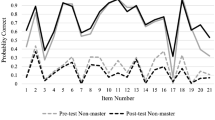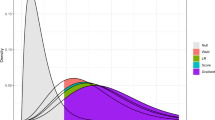Abstract
Item response theory models posit latent variables to account for regularities in students' performances on test items. Wilson's “Saltus” model extends the ideas of IRT to development that occurs in stages, where expected changes can be discontinuous, show different patterns for different types of items, or even exhibit reversals in probabilities of success on certain tasks. Examples include Piagetian stages of psychological development and Siegler's rule-based learning. This paper derives marginal maximum likelihood (MML) estimation equations for the structural parameters of the Saltus model and suggests a computing approximation based on the EM algorithm. For individual examinees, empirical Bayes probabilities of learning-stage are given, along with proficiency parameter estimates conditional on stage membership. The MML solution is illustrated with simulated data and an example from the domain of mixed number subtraction.
Similar content being viewed by others
References
Bock, R. D., & Aitkin, M. (1981). Marginal maximum likelihood estimation of item parameters: Application of an EM algorithm.Psychometrika, 46, 443–459.
Bock, R. D., & Lieberman, M. (1970). Fitting a response model for n dichotomously scored items.Psychometrika, 35, 179–197.
Cohen, L. (1979). Approximate expressions for parameter estimates in the Rasch model.British Journal of Mathematical and Statistical Psychology, 32, 113–120.
Cronbach, L. J., & Furby, L. (1970). How should we measure “change”—Or should we?Psychological Bulletin, 74, 68–80.
Dempster, A. P., Laird, N. M., & Rubin, D. B. (1977). Maximum likelihood from incomplete data via the EM algorithm.Journal of the Royal Statistical Society, Series B, 39, 1–38.
Embretson, S. E. (1985). Multicomponent latent trait models for test design. In S. E. Embretson (Ed.),Test design: Developments in psychology and psychometrics. Orlando: Academic Press.
Falmagne, J-C. (1989). A latent trait model via a stochastic learning theory for a knowledge space.Psychometrika, 54, 283–303.
Gagné, R. M. (1968). Learning hierarchies.Educational Psychologist, 6, 1–9.
Glaser, R. (1981). The future of testing: A research agenda for cognitive psychology and psychometrics.American Psychologist, 36, 923–936.
Glaser, R., Lesgold, A., & Lajoie, S. (1987). Toward a cognitive theory for the measurement of achievement. In R. Ronning, J. Glover, J. C. Conoley, & J. Witt (Eds.),The influence of cognitive psychology on testing and measurement: The Buros-Nebraska Symposium on measurement and testing (Vol. 3, pp. 41–85). Hillsdale, NJ: Erlbaum.
Goodman, L. A. (1974). Exploratory latent structure analysis using both identifiable and unidentifiable models.Biometrika, 61, 215–231.
Haertel, E. H. (1984). An application of latent class models to assessment data.Applied Psychological Measurement, 8, 333–346.
Kelderman, H. (1989). Item bias detection using loglinear IRT.Psychometrika, 54, 681–697.
Kelderman, H., & Macready, G. B. (1990). The use of loglinear models for assessing differential item functioning across manifest and latent examinee groups.Journal of Educational Measurement, 27, 307–327.
Klein, M. F., Birenbaum, M., Standiford, S. N., & Tatsuoka, K. K. (1981).Logical error analysis and construction of tests to diagnose student “bugs” in addition and subtraction of fractions (Research Report 81-6). Urbana, IL: University of Illinois, Computer-Based Education Research Laboratory.
Louis, T. A. (1982). Finding the observed information matrix when using the EM algorithm.Journal of the Royal Statistical Society, Series B, 44, 226–233.
Maris, E. (1992).Psychometric models for psychological processes and structures. Unpublished doctoral dissertation, Katholieke Universiteit Leuven, Belgium.
Masters, G. N. (1988). Item discrimination: When more is worse.Journal of Educational Measurement, 25, 15–29.
McHugh, R. B. (1956). Efficient estimation and local identification in latent class analysis.Psychometrika, 21, 331–347.
Meng, X-L, & Rubin, D. B. (1993). Maximum likelihood estimation via the ECM algorithm: A general framework.Biometrika, 80, 267–278.
Mislevy, R. J. (1984). Estimating latent distributions.Psychometrika, 49, 359–381.
Mislevy, R. J. (1986). Bayes model estimation in item response models.Psychometrika, 51, 177–195.
Mislevy, R. J., & Bock, R. D. (1989). PC-BILOG 3: Item analysis and test scoring with binary logistic models. Mooresville, IN: Scientific Software.
Mislevy, R. J., & Verhelst, N. (1990). Modeling item responses when different subjects employ different solution strategies.Psychometrika, 55, 195–215.
Mislevy, R. J., Wingersky, M. S., Irvine, S. H., & Dann, P. L. (1991). Resolving mixtures of strategies in spatial visualization tasks.British Journal of Mathematical and Statistical Psychology, 44, 265–288.
Paulson, J. A. (1986).Latent class representation of systematic patterns in test responses (Technical Report ONR-1). Portland, OR: Portland State University, Psychology Department.
Ramsay, J. O. (1975). Solving implicit equations in psychometric data analysis.Psychometrika, 40, 361–372.
Rasch, G. (1980).Probabilistic models for some intelligence and attainment tests. Chicago: University of Chicago Press (Originally published in 1960. Danish Institute for Educational Research, Copenhagen).
Rost, J. (1990). Rasch models in latent classes: An integration of two approaches to item analysis.Applied Psychological Measurement, 14, 271–282.
Rubin, D. B. (1984). Bayesianly justifiable and relevant frequency calculations for the applied statistician.Annals of Statistics, 12, 1151–1172.
Samejima, F. (1983).A latent trait model for differential strategies in cognitive strategies (ONR Research Report 83-1). Knoxville, TN: University of Tennessee.
Siegler, R. S. (1981). Developmental sequences within and between concepts.Monograph of the Society for Research in Child Development, 46.
Snow, R. E., & Lohman, D. F. (1989). Implications of cognitive psychology for educational measurement. In R. L. Linn (Ed.),Educational measurement (3rd ed., pp. 263–331). New York: American Council on Education/Macmillan.
Tatsuoka, K. K. (1983). Rule space: An approach for dealing with misconceptions based on item response theory.Journal of Educational Measurement, 20, 345–354.
Tatsuoka, K. K. (1990). Toward an integration of item response theory and cognitive error diagnosis. In N. Frederiksen, R. Glaser, A. Lesgold, & M. G. Shafto, (Eds.),Diagnostic monitoring of skill and knowledge acquisition (pp. 453–488). Hillsdale, NJ: Erlbaum.
Thompson, P. W. (1982). Were lions to speak, we wouldn't understand.Journal of Mathematical Behavior, 3, 147–165.
Wilson, M. (1984).A Psychometric model of hierarchical development. Unpublished doctoral dissertation, University of Chicago.
Wilson, M. (1989a). Saltus: A psychometric model of discontinuity in cognitive development.Psychological Bulletin, 105(2), 276–289.
Wilson, M. (1989b). Empirical examination of a learning hierarchy using an item response theory model.Journal of Experimental Education, 57(4), 357–371.
Wilson, M., & Iventosch, L. (1988). Using the Partial Credit model to investigate responses to structured subtests.Applied Measurement in Education, 1(4), 319–334.
Wright, B. D., & Douglas, G. A. (1977). Conditional versus unconditional procedures for sample-free item analysis.Educational and Psychological Measurement, 37, 573–586.
Yamamoto, K. (1987).A model that combines IRT and latent class models. Unpublished doctoral dissertation, University of Illinois, Champaign-Urbana.
Author information
Authors and Affiliations
Additional information
The authors' names appear in alphabetical order. We would like to thank Karen Draney for computer programming, Kikumi Tatsuoka for allowing us to use the mixed-number subtraction data, and Eric Bradlow, Chan Dayton, Kikumi Tatsuoka, and four anonymous referees for helpful suggestions. The first author's work was supported by Contract No. N00014-88-K-0304, R&T 4421552, from the Cognitive Sciences Program, Cognitive and Neural Sciences Division, Office of Naval Research, and by the Program Research Planning Council of Educational Testing Service. The second author's work was supported by a National Academy of Education Spencer Fellowship and by a Junior Faculty Research Grant from the Committee on Research, University of California at Berkeley. A copy of the Saltus computer program can be obtained from the second author.
Rights and permissions
About this article
Cite this article
Mislevy, R.J., Wilson, M. Marginal maximum likelihood estimation for a psychometric model of discontinuous development. Psychometrika 61, 41–71 (1996). https://doi.org/10.1007/BF02296958
Received:
Revised:
Issue Date:
DOI: https://doi.org/10.1007/BF02296958




